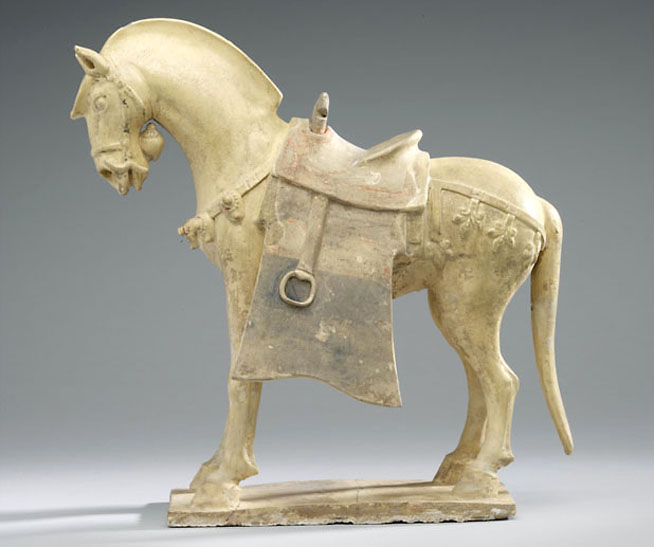Weapon Wednesday: The Horse

The horse is not just a form of transportation, but is a weapon in itself. The genus Equus is thought to have evolved over 4 million years ago in North America, specialising in being able to eat the grass of the steppelands and run away from predators. North American horses later became extinct, possibly due to hunting by humans, although various species of horse, asses and zebras thrived in the Old World. When they first appear in the archaeological record they are probably being hunted by early Modern Humans, as they are depicted with other prey species in Upper Palaeolithic cave art. By about 4,000 years ago humans domesticated the horse, possibly in a number of centres in Central Asia, Western Asia, and also Arabia. It seems not entirely certain that horses were actually used to ride on but certain autheors certainly thought they were. The Royal Standard of Ur is thought to show the first chariot, 4-wheeled and dated to 2600-2400 BC, but it is questionable whether these vehicles were drawn by horses or asses, or possibly even a cross between the two! Certainly within a few hundred years two-wheeled chariots are widespread, and are often found in burials with what are recognisably domesticated horses.

Chariot warfare continued to be an important aspect of warfare across the Old World for some centuries, the Battle of Kadesh in about 1274 BC between the Egypt under Ramesses II and the Hittite Empire under Muwatalli II being arguably the most famous chariot battle of this time. But chariots were only useful on flat terrain and for relatively light fighting, using archery and javelins, it could never charge straight into a force of foot soldiers who were determined to stand their ground. The tactic of chariot warfare is actually preserved in chess, for the "L" shaped path of the Knight is actually that of a chariot, charging forward and then attacking from the side. Eventually chariots became used more for ceremony, transport, symbolism, and for racing.

Silver didrachm with Jupiter on a chariot; struck silver; Rome, Italy; Roman Republican period; about 225 BC; 989.117.1, on display in the Eaton Gallery of Rome (ROM Photography).
For many years the balance betwwen cavalry and infantry was quite balanced, with exceptions like the Battle of Carrhae in 53 BC in which Parthian horse-archers annihilated a much larger army of Roman infantry under Crassus. Eventually Rome fell tp horseman, and it is [ossible that these horseman used an important new invetion: the stirrup. The origins of the stirrup are not fully known. The horse-peoples of Central Asia probably knew how to ride before they could walk, and had little need for such devices, but there is occasionally evidence of them. In India there was an early tradition of the horse-rider putting their big toes through a loop of rope on each side of the horse, but this is not a stirrup. Whatever the stirrups true origins, it was adopted in a large scale in China, with clear evidence in the 4the century AD and being widespread by the 5th century.

Stirrups became widespread across the Old World, and horse-borne warriors came to dominate societies from the knights of Europe to the Samurai of Japan, and everywhere in between. The stirrup defined a new period, the Age of the Stirrup, which lends justification for extending the term "Mediaeval" for the period between the Ancient cultures and the beginnings of gunpowder. During the mediaeval period some horse warriors, and their horse became very heavily armoured, and all of society was geared to maintain these warriors. Howvere, even after gunpowder swept the heavily armoured warrior from the battlefields, the horse remained important in warfrae until the 20th century.

Horse's head armour or Chamfron; Steel, wrought and engraved; Bears the mark of the Istanbul armoury; Mamluk or Ottoman; late 15th to early 16th century; #935X59; Length 60cm; Width 26cm; Depth 8cm
To this day humans have a very close relationship with horses, and the symbolism of the free running horse is still quite potent. In the Chinese calendar the Year of the Horse is a dynamic year for freedom, travel, and adventure.
Further reading
Extinct horses Merychippus, Mesohippus bairdii, and Equus occidentalis
Palaeolithic horse art: here and here
Chariot fittings from Chinese burials, a plaque, axle-caps, and other parts.
The possible origins of Arabia's horses 9,000 years ago.
